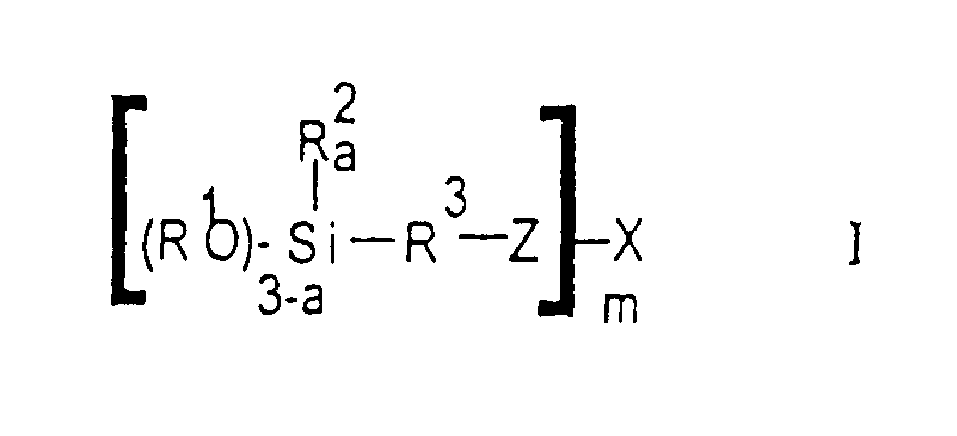Powder coatings or adhesives employing silanes or silane treated fillers
A technology of powder coatings and adhesives, applied in powder coatings, adhesives, coatings, etc., can solve problems such as easy flow, formation of tough films, and difficult low molecular weight components
- Summary
- Abstract
- Description
- Claims
- Application Information
AI Technical Summary
Problems solved by technology
Method used
Image
Examples
Embodiment 1
[0082] Silane carbamate compounds are prepared by the reaction of isocyanatopropyltrimethoxysilane with the polyol compounds listed in Table I. The reaction was carried out under the condition of a total weight of about 30 grams, using a molar ratio of 2:1.05 isocyanatopropyltriethoxysilane: diol and 300-500 ppm of dibutyl tin dilaurate (DBTDL) catalyst. A 100 ml round-bottomed 3-necked flask is equipped with a magnetic stir bar and a thermometer on one side. The equipment includes a heating sleeve with a calorimeter. Use TEFLON in joints Lubricant. The ingredients were transferred into the flask, including a catalyst addition amount of 300-500 ppm DBTDL. Under nitrogen, slowly heat the flask until exotherm occurs. Keep the maximum temperature at about 100°C to reduce the color of the final product. Using IR, according to the disappearance of NCO to control the reaction to complete. Record the appearance and viscosity of the product. If the product is solid, the melting point is...
Embodiment 2
[0085] Preparation of bis[3-(triethoxysilyl)propyl]-1,4-cyclohexane dimethyl dicarbamate
[0086] Under the protection of nitrogen, 199.4 grams of molten cyclohexane dimethanol (purchased from Aldrich) and 685.6 grams of SILQUEST were added to a 2-liter three-necked flask equipped with a magnetic stirrer, thermometer, reflux condenser, and addition funnel. A-1310 (3-isocyanatopropyltriethoxysilane, purchased from Witco Corp.) and 0.44 grams of DBTDL. With good mixing and a little heating, the contents of the flask exothermed up to 146°C. The temperature of the reaction mixture was maintained at 90-110C for 3 hours. As the reaction progresses, the infrared spectrum of the reaction mixture is measured at intervals. When the isocyanate is at 2272cm -1 When the absorption peak at the position almost disappears, the reaction is considered to be over. Once cooled, a white solid is obtained. The melting point of this material was measured by DSC (Differential Scanning Calorimetry) and ...
Embodiment 3
[0088] Preparation of bis[3-(trimethoxysilyl)propyl]-1,4-cyclohexane dimethyl dicarbamate
[0089] SILQUEST to be purchased Y-5187 (3-isocyanatopropyltrimethoxysilane, purchased from WitcoCorp.) was distilled and analyzed by GC to obtain a purity of 98.5%. Under the protection of nitrogen, 21.9 g of molten cyclohexanedimethanol and 0.0101 g (10 ml) of DBTDL were added to a 100 ml three-necked flask equipped with a magnetic stirrer, thermometer, reflux condenser, and addition funnel. The contents are heated to 50°C. Under good stirring, add distilled Y-5187 (3-isocyanatopropyltrimethoxysilane) dropwise. As soon as the addition was started, an exotherm occurred and the temperature of the reaction mixture rose to 100°C. Remove the heat source and continue to add Y-5187 at a rate such that the internal temperature is lower than 100°C. After the addition was complete, the reaction mixture was kept at 85°C for 1 hour. Infrared analysis showed that there was no isocyanate. After cooling...
PUM
| Property | Measurement | Unit |
|---|---|---|
| softening point | aaaaa | aaaaa |
| glass transition temperature | aaaaa | aaaaa |
| melt viscosity | aaaaa | aaaaa |
Abstract
Description
Claims
Application Information
 Login to View More
Login to View More - R&D Engineer
- R&D Manager
- IP Professional
- Industry Leading Data Capabilities
- Powerful AI technology
- Patent DNA Extraction
Browse by: Latest US Patents, China's latest patents, Technical Efficacy Thesaurus, Application Domain, Technology Topic, Popular Technical Reports.
© 2024 PatSnap. All rights reserved.Legal|Privacy policy|Modern Slavery Act Transparency Statement|Sitemap|About US| Contact US: help@patsnap.com








